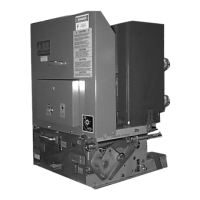IB 6.2.7.7-3I
1
3
1. Back off Adjusting Screw (3) to assure
excessive latch engagement.
2. Close the circuit breaker.
3. Turn Adjusting Screw (3) down slowly until the
Latch just releases, tripping the circuit
breaker.
4. Back off the Adjusting Screw (3) 2 turns.
WARNING
Keep hands clear of all moving parts. Serious
injuries can result if a person comes in contact with
breaker parts when the breaker is being opened or
closed, or closing springs are being charged or
discharged. Use extension tools for manipulating
breaker parts.
Control Device (See Figure A11)
The Control Device is adjusted before leaving the
factory. It is recommended that no attempt be
made to adjust the internal relays and contacts of
this device in the field. If replacement of the
Control Device is required, the Close Latch
Release Rod (5)
overtravel
may be adjusted as
described below.
Close Latch Rod Release Overtravel
1. Back off on Close Latch Release Rod (5) and
check that the circuit breaker will not close
electronically or manually by pushing up on
the Close Latch Release Rod to the full
extent of its travel.
2. Charge the Closing Springs. Push up the
Close Latch Release Rod to the full extent of
its travel and hold.
3. While holding the Close Latch Release Rod
in this position, turn up on the Close Latch
Release Rod until the circuit breaker closes.
Turn the Close Latch Release Rod up an
additional 1-1/2 turns.
Lubrication
All mechanism parts, bearings, pins etc. of the
VHK vacuum circuit breakers have been
lubricated with Anderol 757 during factory
assembly. While any adjustments, tests and/or
periodic maintenance is being performed, it is
recommended that the grease for those parts be
examined.
If the grease should become contaminated or
unduly oxidized (hardened and darkened), or if
parts are replaced, any relubrication should be
done with the same lubricant, available from ABB
as part number 712994-C00 (1 LB can).
Note the following:
•
The mechanism should be periodically inspected
for lubrication contamination. The frequency of
inspection is dependent upon experience with
the operating environment.
•
Anderol is a Lithium soap-based synthetic
lubricant. Anderol is not compatible with many
other lubricants. Mixing with other incompatible
lubricants will cause caking and discoloration
and will require complete purging and
relubrication of breaker parts.
•
Do not apply grease to latch or roller surfaces.
•
Do not use light oil to lubricate any mechanism
parts. In emergency situations, Anderol 732 may
be used as a temporary lubricant, if adequate
time (several hours) is allowed for the solvents to
evaporate prior to any mechanical operations. It
is mandatory that the breaker undergo thorough
lubrication with Anderol 757 as soon as possible.
Note that bearing surfaces must be repacked,
requiring disassembly of the mechanism. Do not
operate the circuit breaker without completing
this procedure.
•
Use of solvents to free contaminated lubricant is
strictly forbidden without immediate relubrication
using Anderol 757.
•
The charging motor has sealed bearings. No
lubrication is required.
Dielectric Tests
It is recommended that dielectric withstand tests
be made prior to use and at routine maintenance
periods to verify the integrity of vacuum circuit
breakers. If, during the dielectric withstand test,

